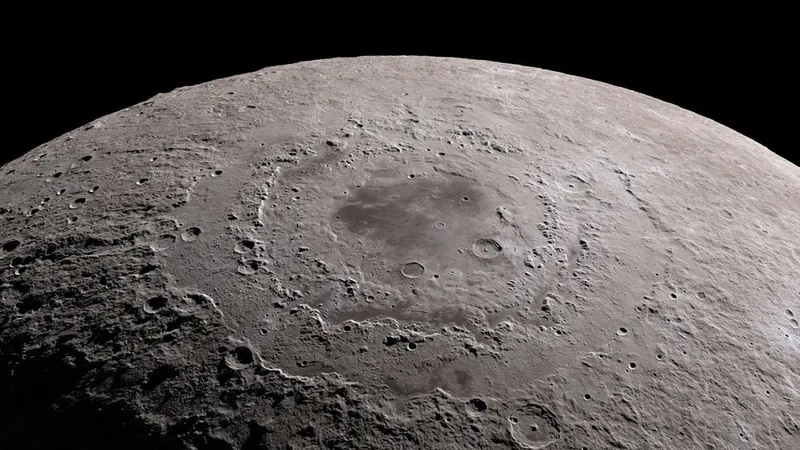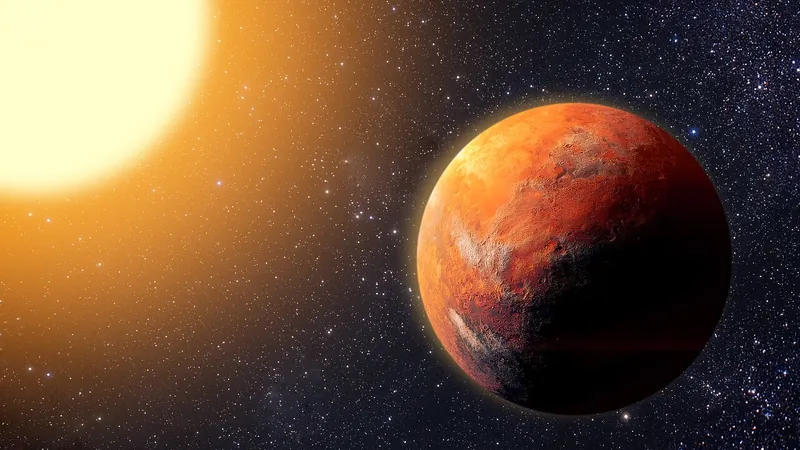
Unlocking Moon's Secrets: New Geological Map Could Revolutionize Sample-Return Missions!
2024-11-22
Author: Arjun
Unlocking Moon's Secrets: New Geological Map Could Revolutionize Sample-Return Missions!
Scientists are on the brink of uncovering the precise age of the moon's giant impact basins, paving the way for future sample-return missions that could dramatically enhance our understanding of both lunar and Earth's impact history. A groundbreaking geological map has been created for Mare Orientale, the youngest large impact site on the moon, which may hold the key to answering age-old questions about our celestial neighbor.
Mare Orientale: The Youngest Large Impact Site
Mare Orientale, prominently located at the edge of the moon’s visible surface from Earth, lies at the intersection of the lunar near and far side. This vast expanse, formed by ancient basaltic lava flows, is notably darker than the surrounding highlands—giving the moon its characteristic 'man in the moon' appearance. Historically mistaken for seas due to their smooth surface, the term "Mare" is derived from Latin, meaning "sea."
Age and Significance of Mare Orientale
Among the moon's maria, Mare Orientale is particularly intriguing as it is believed to be the youngest, estimated to be around 3.8 billion years old. This is in stark contrast to the South Pole-Aitken basin, which is calculated to be over 4.3 billion years old. Understanding the precise formation history of these large impact sites not only helps to date the moon but also sheds light on the violent early days of Earth when it experienced its share of cataclysmic impacts.
Geological Structure and Challenges
The structure of the Orientale basin is mesmerizing, characterized by a double-ring formation that spans a staggering 580 miles (930 kilometers) in diameter. The impact that created this basin rendered the lunar surface white-hot and melted it, leading to the formation of basaltic rock that can reveal critical information about when the basin solidified.
However, pinpointing the exact age of the Mare Orientale has proven challenging, as its surface has been obscured over billions of years by younger lava flows and countless new impact craters. In response to this challenge, a team led by Kirby Runyon from the Planetary Science Institute in Tucson, Arizona, has developed a detailed map designed to locate the original impact melt buried beneath layers of subsequent geological activity.
The New Geological Map
The new geological map categorizes two distinct types of formations: the cracked yet smooth basin floor material, referred to as "BFsc," and the smaller youthful impact craters represented as stars on the map. While the latter has raised concerns about contaminating age measurements, there is a chance these younger craters could have originated from the same impact melt material leading to an exciting method for dating the area.
Runyon emphasized the significance of their findings: “If samples from the younger craters yield the same age as those from the BFsc areas, we can confidently apply this technique to other, more degraded basins on the moon.
Future Missions and Implications
Future lunar sample-return missions could finally put these theories to the test, having profound implications on our understanding of impact history on both the moon and Earth. Considering the moon’s surface serves as an archive of the solar system's violent past, such missions could help construct a clearer picture of the frequency and intensity of giant impacts during the solar system's formative years.
Mare Orientale and Earth’s Early History
The Mare Orientale, with its fascinating blend of age and geological youth, serves as an ideal candidate for this research. By dating the Orientale basin with its still-exposed impact melt, scientists hope to establish a timeline for the formation of similar structures on the moon. The more craters visible on a surface, the older it is assumed to be, making Mare Orientale a timeline critical to reconstructing early solar system events.
The outcomes of these explorations could redefine our understanding of Earth’s own tumultuous early conditions. Runyon pointed out an intriguing possibility: “The moon acts like Earth's attic, preserving the records of ancient impacts—it's where we can uncover Earth's 'baby photos.'”
The Profound Effect of Giant Impacts
Moreover, the implications of these giant impacts are profound. They could have drastically altered the course of evolution on Earth, causing oceans to vaporize and potentially delaying—or even thwarting—the emergence of life. Recent models suggest that while the Earth may not have been entirely sterilized during such events, there is evidence to propose that impacts could have sent our oceans into a cycle of vaporization and re-condensation, delaying life’s foothold.
Conclusion
In conclusion, understanding the significant impacts on the moon not only helps illuminate its history but also reflects the chaotic formations that shaped our own planet. As scientists prepare for future missions to sample these lunar sites, the knowledge gained could forever change our perspective on the cosmic forces that molded Earth and its companion in space—the moon. Stay tuned for more revelations from our celestial neighbor!





 Brasil (PT)
Brasil (PT)
 Canada (EN)
Canada (EN)
 Chile (ES)
Chile (ES)
 España (ES)
España (ES)
 France (FR)
France (FR)
 Hong Kong (EN)
Hong Kong (EN)
 Italia (IT)
Italia (IT)
 日本 (JA)
日本 (JA)
 Magyarország (HU)
Magyarország (HU)
 Norge (NO)
Norge (NO)
 Polska (PL)
Polska (PL)
 Schweiz (DE)
Schweiz (DE)
 Singapore (EN)
Singapore (EN)
 Sverige (SV)
Sverige (SV)
 Suomi (FI)
Suomi (FI)
 Türkiye (TR)
Türkiye (TR)